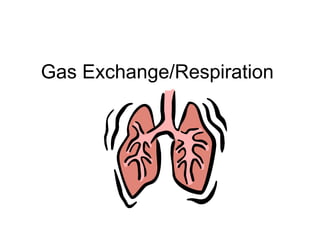
Gas_Exchange.ppt
- 2. Gas Exchange =Exchange CO2 for O2 =Need Respiratory Surface – Needs to be thin for diffusion – Needs to be moist for diffusion – Needs to be in contact with gases
- 3. Gas Exchange/Protists CO2 O2 Respiratory surface is the cell membrane What drives the diffusion?
- 4. Gas Exchange/Hydra • Diffusion through cell membranes (respiratory surface) O2 CO2
- 5. Gas Exchange/Worm • Worms live in moist soil • Oxygen from air goes into soil • Thin, mucus-coated, skin is their respiratory surface (Gas exchange across skin) • If skin dries, they suffocate (Worms can also drown in water- Low O2 levels in water compared to air!) Oxygen in Air CO2 CO2
- 6. But how do the gases get transported to the center of the worm?
- 7. Need a transport system • Need vessels • Need blood with an oxygen-carrying molecule, a respiratory pigment (ex. Hemoglobin) • 100ml of water can carry 0.2ml of O2 • 100ml of blood can carry 20.0ml of O2
- 8. Gas Exchange/Grasshopper Spiracles= 5 pairs of openings Allow O2 in and CO2 out
- 10. Gas Exchange/Grasshopper • Tracheal tubes branch through body • They end with a moist, thin membrane that butts up against body cells (respiratory surface) • Body movements allow for air to come in and out of tracheal system • No Hemoglobin in blood and blood not used for gas transport
- 11. Gas Exchange/Aquatic • Gills – layers of tissue rich in blood – Large surface area – O2 gas is dissolved in H2O – H20 with O2 gas washes over gills – Exchange gases – Need constant flow of water over gills or they suffocate – Gills covered by operculum flap
- 13. Gas Exchange/Humans • Respiratory Surface= Lungs
- 14. Lungs • Bronchi part of respiratory system but not part of lung
- 15. Air • Inhaled (Breath In): – 79% Nitrogen Gas – 20.9% Oxygen – 0.04% CO2 – water • Exhaled (Breath out): – 79% Nitrogen Gas – 16.3% Oxygen (CPR) – 4.5% CO2 – water
- 16. Route of Air 1. Nose (Nasal passages) • Hair for filtration • Mucus to moisten air • Blood vessels to warm air • Don’t get this with mouth breathing 2. Pharynx 3. Larynx (Voice Box with vocal cords made of cartilage) Tyler Vid
- 17. Route of Air 4. Trachea (Windpipe) – Get open by rings of cartilage – Lined with a ciliated mucus membrane – Coughing reflex Tobacco smoke paralyzes cilia (1 cigarette=20min of paralysis) Also increase mucus production
- 18. Route of air 5. Bronchi – Ringed – 2 – ciliated
- 19. Route of air 6. Bronchial Tubes 7. Bronchioles – No rings – Tiny tubes – Open into the… 8. Alveoli
- 20. Lung Volume • Tidal Volume=500ml of air in and out during rest (3500ml- exercise ) 12 breaths/min(6L/min)Rest 40 breaths/min(42L/min)Exercise • Functional Residual Capacity=always left with 2300ml air after breathing out
- 21. Alveoli Like cluster of grapes 300 million alveoli 70 sq meter surface area Walls of air sacs are one cell thick Site of gas exchange
- 22. Problems • Emphysema – Destruction of alveoli walls – Scar tissue from macrophage attack – Reduced breathing ability • Asthma – Allergic reaction in bronchioles with their subsequent closing – Treat with Epinephrine mist • Lung Cancer • Pneumonia – Fluid in alveoli • Tuberculosis – Immune attack leaves scars that thicken alveoli and affect diffusion • Bronchitis – Inflammation of bronchial tubes
- 23. Process of Inhalation (Active) 1. Rib muscles pull ribs up and out 2. Diaphragm muscle pulled down 3. Now low air pressure in chest 4. Air sucked into chest 5. Alveoli expand
- 24. Process of Exhalation (Passive) • Diaphragm relaxes and goes back up • Rib muscles relax • Ribs go down and in • Increase pressure in chest • Air squeezed out of lungs
- 26. Lung Model
- 27. Air pressure and altitude • High altitudes have lower air pressure than at sea level • High altitudes have lower concentration of O2 compared to sea level
- 28. Planes are pressurized and pump oxygen into the plane
- 29. Air pressure and altitude • What happens to our blood when we go suddenly from high pressure to low pressure environments?
- 30. Nitrogen gas in blood bubbles out The “Bends”
- 31. The Bends
- 32. Andes Mountains in Peru Have a high red blood cell count More red bone marrow More developed lungs
- 33. Breathing Regulation • Involuntary • Have Chemoreceptors in walls of arteries that detect CO2 levels • High CO2 levels in blood detected and send message to respiratory center of brain (Medulla) • Medulla send message to diaphragm and rib muscles to increase rate and depth of breath • Low pH of blood also stimulates medulla
- 34. External vs. Internal Respiration • External – Gas exchange in alveoli with capillaries • Internal – Gas exchange in capillaries with body cells
- 35. Oxygen transport • In lungs oxygen combines with Hemoglobin to form oxyhemoglobin
- 36. Oxygen Transport • Oxygen released in locations of low O2 concentration • Carbon monoxide has greater binding ability to hemoglobin than oxygen
- 37. Carbon Dioxide Transport • 70% as Bicarbonate in plasma CO2 + H20 H2CO3 H++ HCO3 -
- 38. Carbon Dioxide Transport • 20% as carbaminohemoglobin CO2 + Hb HbCO2 (HbCO is carboxyhemoglobin)
- 39. Carbon Dioxide Transport • 10% as free CO2 in plasma
- 41. • Video 1 • video 2